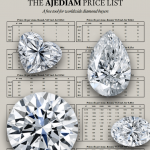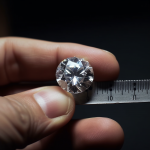Diamond Prices
Read moreThe Blue Heart Diamond
The Most Beautiful Diamond In The World?
Having the reputation of being the most beautiful jewel of them all, the Blue Heart Diamond is a rare gemstone that easily draws its viewer’s eye. At 30.62 carats, it certainly is not the largest precious stone. However, it is one of the most unique diamonds in the world, its deep blue color and heart shape make it extremely rare. The Blue Heart Diamond has been the largest blue heart-shaped diamond in the world since 1909 and is currently part of the Smithsonian Institute’s collection, where it remains waiting to envelop gemstone enthusiasts with its magnificence.
If you’d like to learn more about the Blue Heart Diamond, in this article you will find:

- Discovered in
- 1908
- Country of Origin
- South Africa (Premier Mine)
- Mine of Origin
- Premier Mine
- Carat Weight
- Initially 100.5 carats, cut down to 30.62 carats
- Cut Shape
- Heart-shaped brilliant cut
- Clarity
- VS-2 (Very Small Inclusions)
- Color
- Natural fancy deep blue
- Previous Owners
- Premier Transvaal Diamond Mining Company
- Pierre Cartier (French jeweler)
- Maria Unzue of Argentina
- Van Cleef & Arpels
- Baron Hans Heinrich Thyssen-Bornemisza (Swiss industrialist)
- Harry Winston
- Mrs. Marjorie Merriweather Post
- Current Owner
- Smithsonian Institute, National Museum of Natural History, Washington DC
- Estimated Value
- Unknown
The Origins of the Blue Heart Diamond
For many years, the origins of the Blue Heart Diamond were veiled in mystery. Scholars assumed that the diamond was found somewhere at the beginning of the 20th century and believed it is likely that it originated in South Africa. However, many disagreed and stated the gem could have originally been excavated in India.
The Blue Heart Diamond receives its name
When the Smithsonian Institute acquired the diamond in 1964, they did an extensive study on it which determined that the stone was indeed South African! It turns out the Blue Heart Diamond was discovered in the famous Premier Mine in 1908. Many other significant diamonds were unearthed at that very site, such as The Cullinan, The Taylor-Burton, The Premier Rose, and many more.
It is easy to see how the name of the Blue Heart Diamond was inspired. Although it has sometimes been referred to as the Unzue diamond, seeing it been cut into a rare heart shape and that the stone is imbued with a deep-blue color, any other name for it seems wrong. Its less popular name stems from Maria Unzue of Argentina, who was the owner of the gem for 43 years.
The Blue Heart was also incorrectly referred to as ‘Eugenie Blue’ for many years because Eugénie de Montijo, Empress of France from 1853-1870 was thought to have been its owner for a while. However, a key factor that dismisses the idea is that the diamond was only found in 1908 long after her reign had finished. There are also no connections between the gemstone and France, except for its cutting. The Smithsonian’s study of the Blue Heart Diamond concluded that there was no link between Empress Eugenie and the diamond.
The Cutting of the Blue Heart Diamond
The Premier Transvaal Diamond Mining Company purchased the Blue Heart Diamond in 1909. In 1910, the process of cutting the diamond started. The French, Paris-based Jeweler Atanik Eknayan was tasked with cutting the Blue Heart. When the rough stone arrived, it was 100.5 carats but after Eknayan was through with it, the stone was reduced to its current 30.62 carats. He chose the unusual heart shape of the jewel.
The gemstone was set as the centerpiece of a lily-of-the-valley ornament necklace in the same year. The diamond remained set in this piece until 1953. In that year, Van Cleef & Arpels bought it and reset it into an elegant pendant featuring other precious stones such as a pink 2.05-carat diamond. In 1959, the Blue Heart Diamond now belonged to Harry Winston and was reset again; this time as the centerpiece of a platinum ring. The Blue Heart was now, surrounded by 25 round brilliant-cut colorless diamonds amounting to an overall weight of 1.63 carats
The Modern Ownership History of the Blue Heart Diamond
In 1909, the Premier Transvaal Diamond Mining Company bought the diamond and entrusted it to Atanik Eknayan in Paris who cut the diamond into the 30.62-carat brilliant-cut, heart-shaped diamond we know today.
A prominent Argentinian family purchases the Blue Heart Diamond
The following year, Pierre Cartier, the French jeweler, purchased the diamond. Cartier is the one who had the gemstone set in a lily-of-the-valley ornament necklace. The Blue Heart remained in this form for many years. Cartier sold the jewel to Maria Unzue of Argentina in the same year (1910). The necklace stayed with the Unzue family for quite some time. Maria Unzue gifted it to her niece Angela Gonzalez Alzaga as a present for the latter’s wedding. The jewel stayed with the family until 1953. This meant the Unzues owned it for 43 years – the longest the Blue Diamond has ever been in a private collection for.
The Blue Diamond is reset in several jewels
Van Cleef & Arpels purchased the diamond in 1953. This is also the first time the stone was reset in a different jewel. The Blue Heart featured as the centerpiece of a pendant necklace which featured another 3.81-carat blue diamond from the original necklace and a newly added 2.05-carat pink diamond. The new necklace was valued at $300,000 (over $3,000,000 nowadays).
The company then sold the new jewel to Baron Hans Heinrich Thyssen-Bornemisza – an industrialist from Switzerland. It stayed with him for only 6 years. Harry Winston bought the Blue Heart in 1959 from Nina Dyer – Thyssen-Bornemisza’s ex-wife. Winston decided to reset the precious gemstone once more. He had the diamond set as the centerpiece of a platinum ring. The Blue Heart is surrounded by 25 brilliant-cut round colorless diamonds. Their collective weight amounts to 1.63 carats.
Mrs. Marjorie Merriweather Post bought the ring from Harry Winston for an undisclosed amount in the same year (1959). Mrs. Post was a prominent socialite and founded General Foods Inc.
The Blue Heart Diamond is donated to the Smithsonian Institute
Mrs. Post was the last private owner of the Blue Heart. She decided she did not need the jewel any longer. Instead of selling it, Mrs. Post made a generous gesture. She donated the beautiful diamond to the National Museum of Natural History of the Smithsonian Institute, in Washington DC in 1964. The Blue Heart Diamond has remained a part of their gem collection. It can be seen on display in the Janet Annenberg Hooker Hall of Geology, Gems, and Minerals.
The Technical Characteristics of the Blue Heart Diamond
The Blue Heart Diamond was cut down from 100.5 carats and resulted into 30.62 carats diamond, roughly two-thirds of the size of the Hope Diamond (45.52 carats). It shows a beautiful blue color, which is one of the rarest colors found in diamonds. The precious gemstone possesses a very deep shade of color, which is even rarer. GIA, the Gemological Institute of America, graded it as a natural fancy deep blue diamond. The blue colour in diamonds comes from trace amounts of boron in their atomic structure.
The Blue Heart is a heart-shaped brilliant-cut gemstone. The shape is unusual and was probably responsible for the loss of 70% of its original weight. However, it does make the jewel unique and very rare. The GIA has given a clarity grade of VS-2 to the stone. VS stands for very small inclusions. This is a lower clarity grade, however still a good one. It means that there are no inclusions visible.
The Significance of the Blue Heart Diamond
The Blue Heart Diamond is often regarded as the prettiest blue diamond in the world. Although it is not the biggest, the Blue Heart enjoys the title of being the largest heart-shaped blue diamond in the world. It has maintained its reputation since its cutting in Paris back in 1909. Blue diamonds are really hard to find and larger ones even more so, the Blue Heart’s standing will probably remain uncontested for quite some time.
Heart-shaped gemstones are rarely the cutter’s first choice of shape. This is because crafting a stone into this iconic shape is very complicated and takes vast expertise. It is an intricate process which is why there are not a lot of diamonds in the world with this shape. So, aside from its outstanding hue of deep blue, its shape just makes the Blue Heart diamond that much more unique and rare.
The donation of the Blue Heart Diamond to the Smithsonian Institute
The last private owner of the Blue Heart Diamond, Mrs. Marjorie Post gifted the precious gemstone to the Smithsonian Institute as a gesture of great generosity. More often than not, beautiful diamonds get lost in private collections throughout the years. This sometimes means that they get lost never to be found again. In other cases, they are never shown in public, and because of this attitude, scientific studies are rarely conducted on them.
For any diamond connoisseur, it is clear why studies and gradings of diamonds are important. They help the world have a better understanding of these fascinating stones and drive the industry forward. The Blue Heart has left its mark on the world and is available for all to see in the National Museum of Natural History in Washington DC. It can be found in the Janet-Annenberg Hooker Hall of Geology, Gems & Minerals.
We hope you enjoyed the read!
If you’d like to read about other famous diamonds like the Orlov, Kimberley, or Premier Rose diamonds, you can visit Ajediam’s Famous Diamonds glossary. Or, if you’re feeling inspired, you can browse Ajediam’s premium diamond collections shop.



